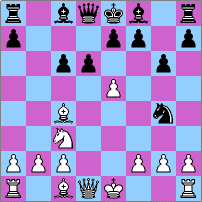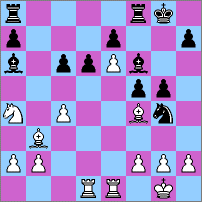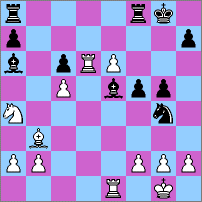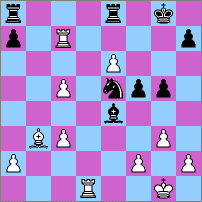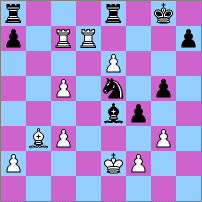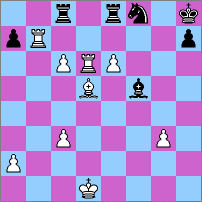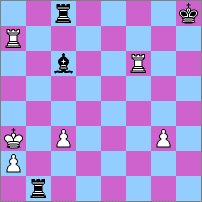Carl Schlechter - Emanuel Lasker
Sicilian Defence [B34]
Berlin, game 7, 19101.e4 c5 2.Nf3 Nc6 3.d4 cxd4 4.Nxd4 Nf6 5.Nc3 g6 6.Bc4
More normal today would be 6.Nxc6 bxc6 7.e5 with a slight advantage after either 7...Ng8 or 7...Nh5.
6...d6 7.Nxc6 bxc6 8.e5 Ng4
Taking on e5 would have been disastrous: 8...dxe5?? 9.Bxf7+!
9.e6!?
Risky according to Capablanca. I guess that means it is risky! Taking on d6 would lead to simpler play with a slight advantage. With the move played, White cramps his opponent but Black always has chances due to his potentially strong centre pawns.
9...f5 10.0-0 Bg7
The tempting 10...d5? has to be rejected because of 11.Nxd5 cxd5 12.Bb5+.
11.Bf4 Qb6 12.Bb3 Ba6 13.Na4 Qd4 14.Qxd4 Bxd4 15.c4 0-0 16.Rad1 Bf6 17.Rfe1 g5
Now, rather than retreating (which was perfectly playable), Schlechter sacrifices a piece to set up some menacing passed pawns. A very exciting game takes shape...
18.Bxd6!? exd6 19.Rxd6 Be5 20.c5
20...Rfe8?!
A splendid forcing sequence occurs after 20...Bxh2+ 21.Kh1 Bxd6 22.cxd6 Nxf2+ 23.Kg1 Ne4 24.e7+ Kg7 25.exf8Q+ Rxf8 26.Rxe4 fxe4 27.Nc5! Bc8! 28.Be6! (28.d7 Bxd7 29.Nxd7 Rd8 and Black is very happy) 28...Kf6! (playing to win; old analysis concluded that 28...Bxe6 29.Nxe6+ Kf7 30.Nxf8 Kxf8 31.Kf2! Kf7 32.Ke3 Ke6 33.Kxe4 Kxd6 34.Kf5 would lead to a draw) 29.d7 Ba6 30.Bg4 Bc4 with a clear black advantage, as given in the Deutsches Wochenschach in 1910. Very attractive analysis!
Instead of that, after 20...Re8 the game becomes very unclear, but with White having the better practical chances.21.g3 Bf6
According to Schlechter taking the rook would be wrong - after 21...Bxd6 22.cxd6 the pawns are too strong. Now White pockets another pawn.
22.Rxc6 Bb7 23.Rc7 Be4 24.Nc3 Bxc3 25.bxc3 Ne5 26.Rd1
26...Nf3+
Now the White king comes under fire. The pieces start to perform some merry dances as they jockey for coordination.
27.Kf1 Nxh2+ 28.Ke1 Nf3+ 29.Ke2 Ne5 30.Rdd7 f4
31.Rg7+ Kh8 32.Rxg5 Bd3+ 33.Kd1 fxg3! 34.fxg3 Ng6 35.Rd5The rook seems to want to carve out the d7-g7-g5-d5 rectangle. the main target was the g5 pawn.
35...Be4 36.Rd6 Bf5
Bernstein suggested hanging on to the a7 pawn with 36...a5.
37.Bd5 Rab8 38.c6 Nf8 39.Rb7 Rbc8
White seems to have a winning sequence now, but Black is saved by the check on move 42. Yet another tactical trick in a game full of splendid geometrical pirouettes.
40.e7 Ng6 41.Bf7 Rxe7 42.Bxg6 Bg4+ 43.Kc1 Re1+ 44.Kb2 hxg6 45.Rxg6 Bf5 46.Rf6 Be4 47.Rxa7 Rb1+ 48.Ka3 Bxc6
White has an obvious perpetual check with the rook on f6 and took the draw. He could conceivably have played on with 49.c4 or 49.g4, but the pawns look too scattered to pose Black any real problem.
Game Drawn
